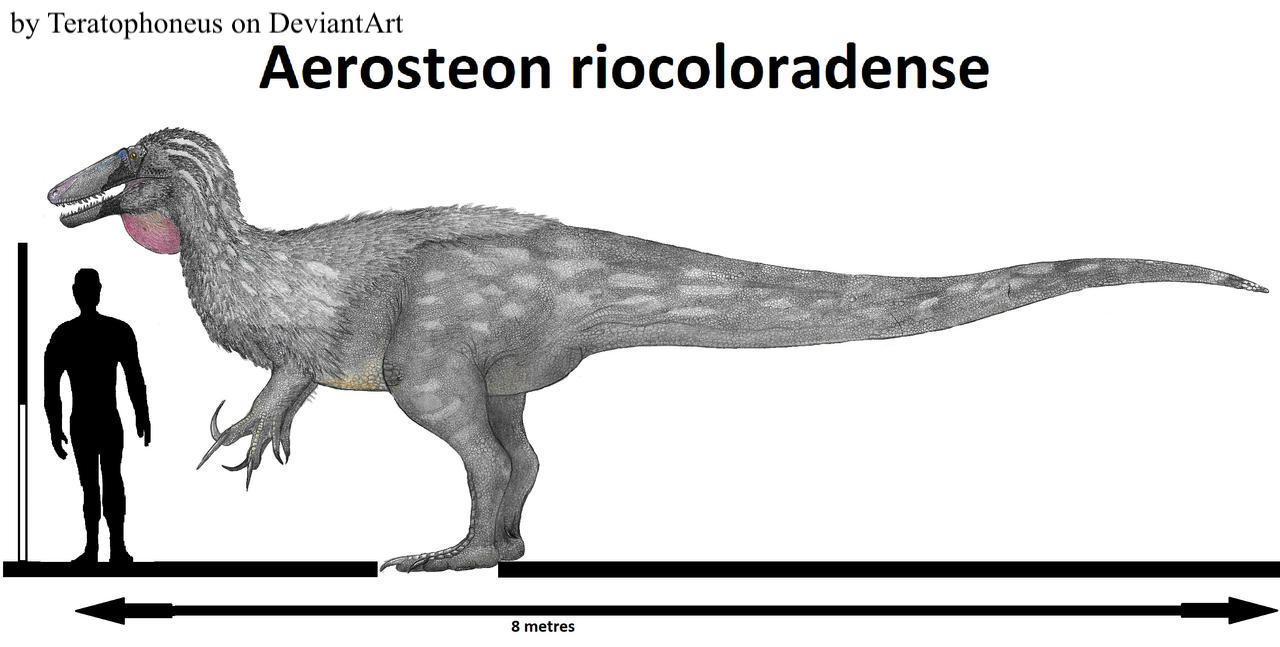Welcome to Aerosteon

Name Definition
Air bone
Name Given By
Paul Sereno et al., 2009
Location
Plottier Formation in Argentina, South America
Classification
Dinosauria, Saurischia, Theropoda, Tetanurae, Megaraptora, Megaraptoridae
Size
2 - 3 meters tall, around 6 or 7 meters long, Gregory S. Paul estimates Aerosteon to be around 500kg (1,100 lbs) while Molina-Pérez estimated its weight at around 1 metric ton (2,200 lbs)
Temporal Range
Santonian stage of the late Cretaceous, around 84 million years ago
Ecological niche
apex predator
Species/Sub Species
A. riocoloradense
Diet
Aerosteon would have probably frequented large titanosaurs like Notocolossus or Petrobrasaurus for a diet
Introduction
Aerosteon is a genus of megaraptoran theropods that lived in Argentina during the late Cretaceous. Aerosteon means “air bone” in Greek while its species name is named after the city San Luis Río Colorado, Mexico. Aerosteon was a part of the clade Megaraptora, a group of lightly-built theropods that have been the subject of debate of whether they are more related to the coelurosaurians or the carnosaurians. Like many megaraptorans, Aerosteon is most notable for having enlarged claws on their digits of the hand as well as an elongated snout, longer than most theropods, which makes them somewhat similar to the spinosaurids in anatomy, though they have never been suggested to be related to each other. The type genus of this clade is of course Megaraptor which it is named after, however, Megaraptor has been incorrectly classified before. Like all megaraptorids and megaraptorans, Megaraptor did have an enlarged claw at its digits, though scientists mistook this large digit claw for the signature sickle claw of most dromaeosaurids, meaning it would have been on the feet, and they named it Megaraptor, the raptor suffix being common in most dromaeosaurids. However, the discovery of a complete limb from Megaraptor has helped scientists conclude that Megaraptor had a large front claw. The hands of Megaraptor were unusually elongated and the claws were even more curved than those of spinosaurids. While Megaraptor did remain miscellaneous for some time, new discoveries like Australovenator (a megaraptoran from Australia) and Aerosteon helped form a new clade and a new family too, consisting of theropods like Tratayenia and Orkoraptor. Aerosteon, however, is one of the more special theropods in both this group and theropods in general. Aerosteon is named after the air-filled cavities that were found in its bones, most likely because of pneumatization (a process where holes in your bones develop to help you breathe). Because of this, the bones would have been exceptionally lightweight (because of its hollow nature), as well as the fact that it may have supported a respiratory system similar to that of modern day birds. Because of these bone cavities, it may have helped Aerosteon respirate very quickly like how birds do in order to sustain flight for long distances, and it would have lived a very active predatory life. A close relative of Aerosteon, Murusraptor, has also been reported to have a smaller level of pneumaticity, and are also anatomically similar. However, they are differentiated by their dentition which are more different than the rest of the body. Another noticeable difference is the ilium (the large broad bone that makes the upper half of the pelvis) in Aerosteon is taller than that of Murusraptor.